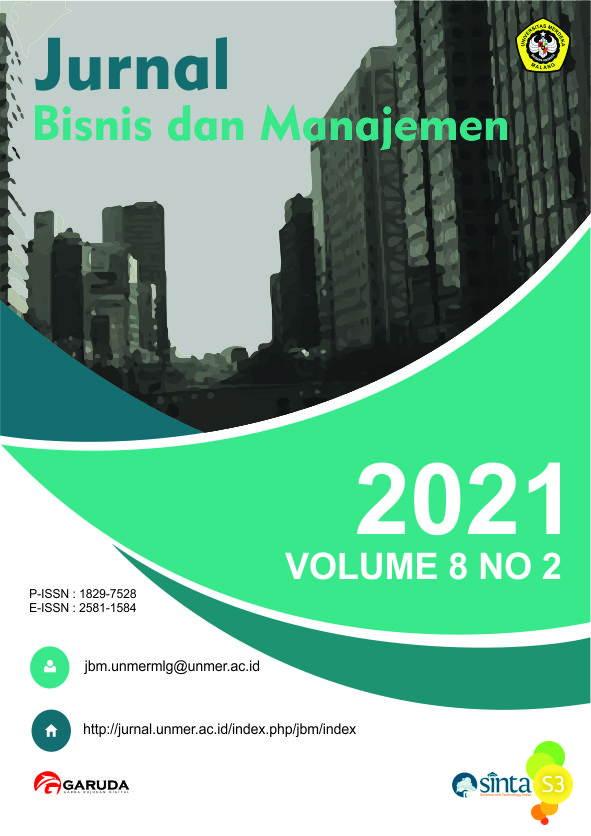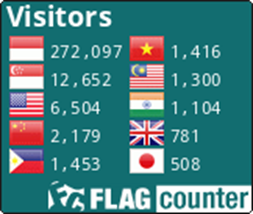Leverage dan Market Share sebagai Faktor Penentu Posisi Persaingan Pasar Perusahaan Manufaktur di Indonesia
DOI:
https://doi.org/10.26905/jbm.v8i2.6375Keywords:
Capital Structure, Competitive Position, Leverage, Market ShareAbstract
This study aims to examine the simultaneous relationship between leverage and market share as a determinant of market competition for manufacturing companies in Indonesia. The model used in this study is the TSLS (Two Stage Least Square) and testing with OLS (Ordinary Least Square), the testing tool used is SPSS. The object of research used in this study is a Manufacturing Company listed on the Indonesia Stock Exchange from 2015-2020 with a total of 122 companies that have fit with criteria for the research sample. The results of the study show that the two endogenous variables: leverage and market share, have a significant positive correlation with each other, which means that there is a simultaneous relationship between leverage policy and market share as an indicator of the competitive position of the product market.
Downloads
References
Amedi, A. M. R., & Mustafa, A. S. (2020). Board Characteristics and Firm Performance: Evidence from Manufacture Sector of Jordan. Accounting Analysis Journal, 9(3), 146–151. https://doi.org/10.15294/aaj.v9i3.39577
Ande, D. F. (2018). PT. HM. Sampoerna Tbk and Its Strategies Becoming a Market Leader Since 2006. Jurnal Ekonomika Dan Manajemen, 7(1), 121.
Bambang, M., & Hermawan, M. S. (2013). Founding Family Ownership and Firm Performance in Consumer Goods Industry: Evidence from Indonesia. SSRN Electronic Journal, 4(2), 112–131. https://doi.org/10.2139/ssrn.2292375
Bas, T., Muradoglu, G., & Phylaktis, K. (2009). Determinants of Capital Structure in Developing Countries. Business, February 2016, 1–38.
Blundell, R., Griffith, R., & Van Reenen, J. (1999). Market share, market value and innovation in a panel of British manufacturing firms. Review of Economic Studies, 66(3), 529–554. https://doi.org/10.1111/1467-937X.00097
Bolton, P., & Scharfstein, D. S. (1990). A theory of predation based on agency problems in financial contracting. The American Economic Review, 80(1), 93–106. http://www.jstor.org/stable/10.2307/2006736
Boubaker, S., Saffar, W., & Sassi, S. (2017). Product Market Competition and Debt Choice. Journal Of Corporate Finance, 2017, 1–28.
Buzzell, R. D., Gale, B. T., & Sultan, R. G. M. (1975). Market Share - A Key to Profitibility. Harvard Business Review, 53(1), 1–9.
Chen, J., Jiang, C., & Lin, Y. (2014). What determine firms’ capital structure in China? Managerial Finance, 40(10), 1024–1039. https://doi.org/10.1108/MF-06-2013-0163
Chen, Y., & Hammes, K. (2003). Capital structure. Theories and Empirical Result - A Panel Data Analysis. Journal of Economic Perspectives, 15(2), 81–102. https://doi.org/10.1257/jep.15.2.81
Das, C. P., & Swain, R. K. (2018). Influence of Capital Structure on Financial Performance. Parikalpana, KIIT Journal of Management, 14(1), 161–171.
Davies, S. W., & Geroski, P. A. (1997). Changes in concentration, turbulence, and the dynamics of market shares. Review of Economics and Statistics, 79(3), 383–389. https://doi.org/10.1162/003465300556977
Edeling, A., & Himme, A. (2018). When does market share matter? New empirical generalizations from a meta-analysis of the market share-performance relationship. Journal of Marketing, 82(3), 1–24. https://doi.org/10.1509/jm.16.0250
Ferrier, W. J., Smith, K. G., & Grimm, C. M. (1999). The role of competitive action in market share erosion and industry dethronement: A study of industry leaders and challengers. Academy of Management Journal, 42(4), 372–388. https://doi.org/10.2307/257009
Frésard, L. (2008). Financial Strength and Product Market Behaviors : The Real Effects of Corporate Cash Holdings. May, 1–46.
Ghozali, I. (2009). Analisis Multivariate Lanjutan dengan Program SPSS. Badan Penerbit Universitas Diponegoro.
Gobenvy, O. (2014). Pengaruh Profitabilitas, Financial Leverage dan Ukuran Perusahaan Terhadap Financial Distress pada Perusahaan Manufaktur yang Terdaftar di Bursa Efek Indonesia Tahun 2009-2011. Jurnal Akuntansi Universitas Negeri Padang, 2(1), 1–24.
Gopalakrishnan, M., Libby, T., Samuels, J. A., & Swenson, D. (2015). The effect of cost goal specificity and new product development process on cost reduction performance. Accounting, Organizations and Society, 42, 1–11. https://doi.org/10.1016/j.aos.2015.01.003
Goyal, K., & Kumar, S. (2021). Financial literacy: A systematic review and bibliometric analysis. International Journal of Consumer Studies, 45(1), 80–105. https://doi.org/10.1111/ijcs.12605
Guney, Y., Li, L., & Fairchild, R. (2011). The relationship between product market competition and capital structure in Chinese listed firms. International Review of Financial Analysis, 20(1), 41–51. https://doi.org/10.1016/j.irfa.2010.10.003
Harris, M., & Raviv, A. (1990). Capital Structure and the Informational Role of Debt. The Journal of Finance, 45(2), 321–349. https://doi.org/10.1111/j.1540-6261.1990.tb03693.x
Hendra, S. T. N., & Hartomo, D. D. (2018). Pengaruh Konsentrasi Dan Pangsa Pasar Terhadap Pengambilan Resiko Bank. Jurnal Bisnis Dan Manajemen, 17(2), 35. https://doi.org/10.20961/jbm.v17i2.17176
Ibhagui, O., & Okoloyo, F. O. (2018). Leverage and Firm Performance: New Evidence on The Role of Firm Size. The North American Journal of Economics and Finance, 40(2), 366–374. https://doi.org/doi.org/10.1016/j.najef.2018.02.002
Ibrahim, M. (2017). Capital Structure and Firm Value in Nigerian Listed Manufacturing Companies: an Empirical Investigation Using Tobin’s Q Model. International Journal of Innovative Research in Social Sciences & Strategic Management Techniques, 4(2), 112–125. http://www.internationalpolicybrief.org/images/2017/SEPT-JOURNALS/IRSSSMT/ARTICLE9.pdf
Jensen, M. C., & Smith, Jr., C. W. (2005). Stockholder, Manager, and Creditor Interests: Applications of Agency Theory. SSRN Electronic Journal, July. https://doi.org/10.2139/ssrn.173461
Jensen, M., & Meckling, W. (1976). Theory of the firm: Managerial behavior, agency costs, and ownership structure. The Economic Nature of the Firm: A Reader, Third Edition, 283–303. https://doi.org/10.1017/CBO9780511817410.023
Kale, J. R., Noe, T. H., & Ramirez, G. G. (1991). The Effect of Business Risk on Corporate Capital Structure: Theory and Evidence. The Journal of Finance, 46(5), 1693. https://doi.org/10.2307/2328569
Kalhor, C., & Rooker, H. (2017). The relationship between capital structure and product market competition in US listed company [LUND University]. In International Review of Financial Analysis (Vol. 20, Issue 1). https://doi.org/10.1016/j.irfa.2010.10.003
Kartikasari, D., & Merianti, M. (2016). The effect of leverage and firm size to profitability of public manufacturing companies in Indonesia. International Journal of Economics and Financial Issues, 6(2), 409–413.
Kayo, E. K., Brunaldi, E. O., & Aldrighi, D. M. (2018). Capital Structure Adjustment in Brazilian Family Firms. Revista de Administração Contemporânea, 22(1), 92–114. https://doi.org/10.1590/1982-7849rac2018170004
Khairov, B. G., Khairova, S. M., Biryukov, V. V., & Romanenko, E. V. (2016). Optimization of financial flows of the enterprise based on logistical approach. Indian Journal of Science and Technology, 9(14). https://doi.org/10.17485/ijst/2016/v9i14/91513
Kotler, P. (2004). Marketing Insights From A to Z. Erlangga.
Kotler, P. (2005). Manajemen Pemasaran. jilid 1. (11th ed.). Intan Sejati Klaten.
Kotler, P., & Keller, K. L. (2016). Marketing Management (5th ed.). Pearson Education Limitted.
Kuan, T. H., Li, C. S., & Liu, C. C. (2012). Corporate governance and cash holdings: A quantile regression approach. International Review of Economics and Finance, 24(February 2019), 303–314. https://doi.org/10.1016/j.iref.2012.04.006
Lumapow, L. S. (2018). The Influence of Managerial Ownership and Firm Size On Debt Policy. International Journal of Applied Business and International Management, 3(1), 47–55. https://doi.org/10.32535/ijabim.v3i1.76
Lyandres, E. (2006). Capital structure and interaction among firms in output markets: Theory and evidence. Journal of Business, 79(5), 2381–2421. https://doi.org/10.1086/505239
Michael Adiwijaya. (2007). Analisa Strategi Reposisi Merek Dalam Persaingan Pasar. Jurnal Manajemen Pemasaran, 2(2). http://puslit2.petra.ac.id/ejournal/index.php/mar/article/view/17004
Mitani, H. (2014). Capital structure and competitive position in product market. International Review of Economics and Finance, 29, 358–371. https://doi.org/10.1016/j.iref.2013.06.009
Moeinaddin, M., Nayebzadeh, S., & Ghasemi, M. (2013). The Relationship between Product Market Competition and Capital Structure of the Selected Industries of the Tehran Stock Exchange. International Journal of Academic Research in Accounting, Finance and Management Sciences, 3(3), 221–233. https://doi.org/10.6007/ijarafms/v3-i3/132
Mu, C., Wang, A., & Yang, J. (2017). Optimal capital structure with moral hazard. International Review of Economics and Finance, 48, 326–338. https://doi.org/10.1016/j.iref.2016.12.006
Mukhibad, H., Subowo, S., Maharin, D. O., & Mukhtar, S. (2020). Determinants of debt policy for public companies in Indonesia. Journal of Asian Finance, Economics and Business, 7(6), 29–37. https://doi.org/10.13106/JAFEB.2020.VOL7.NO6.029
Naomi, P., Ekaputra, I. A., & Wibowo, B. (2018). The role of Industrial factors on optimal capital structure proxy: An empirical study on Indonesia manufacture companies. Serbian Journal of Management, 13(1), 105–113. https://doi.org/10.5937/sjm13-16216
Niu, X. (2009). Theoretical and Practical Review of Capital Structure and its Determinants. International Journal of Business and Management, 3(3), 133–139. https://doi.org/10.5539/ijbm.v3n3p133
Panda, B., & Leepsa, N. M. (2017). Agency theory: Review of theory and evidence on problems and perspectives. Indian Journal of Corporate Governance, 10(1), 74–95. https://doi.org/10.1177/0974686217701467
Porter, M. E. (1998). Competitive Strategy. Techniques Fors Analyzing Industries and Competitors (Vol. 2, Issue 1). The Free Press. https://doi.org/10.1002/smj.4250020110
Ross, S. A. (1977). Determination of Financial Structure: the Incentive-Signalling Approach. Bell J Econ, 8(1), 23–40. https://doi.org/10.2307/3003485
Ross, S., Westerfield, R. W., & Jordan, B. D. (2009). Pengantar Keuangan Perusahaan. Buku 1. Terjemahan Oleh Ali Akbar Yulianto. Salemba Empat.
Rushpaka, B. N. V. (2020). Pengaruh Struktur Modal Terhadap Daya Saing Pasar Produk. Jurnal Ilmiah Bisnis Dan Ekonomi Asia, 14(1), 65–73. https://doi.org/10.32812/jibeka.v14i1.157
Santos, A., Rindra, E., Hidayat, A. A., & Adelina, Y. E. (2020). Dividend and leverage in Indonesian intergenerational family firms. Jurnal Siasat Bisnis, 24(1), 43–58. https://doi.org/10.20885/jsb.vol24.iss1.art4
Santoso, A. (2018). Pengaruh Profitabilitas, Ukuran Perusahaan dan Tingkat Pertumbuhan terhadap Nilai Perusahaan Manufaktur di Indonesia dengan Struktur Modal sebagai Variabel Moderating. Petra Business & Management Review, 4(1), 130–141. http://publication.petra.ac.id/index.php/breview/article/view/9160
Sarkar, S. (2018). Optimal DOL (degree of operating leverage) with investment and production flexibility. International Journal of Production Economics, 202, 172–181. https://doi.org/10.1016/j.ijpe.2018.05.022
Schorr, A., & Lips, M. (2019). The optimal capital structure of Swiss dairy farms. Agricultural Finance Review, 79(3), 323–337. https://doi.org/10.1108/AFR-05-2018-0034
Shaferi, I., Wahyudi, S., Mawardi, W., Hidayat, R., & Puspitasari, I. (2020). The manufacture and service companies differ leverage impact to financial performance. International Journal of Financial Research, 11(2), 281–286. https://doi.org/10.5430/ijfr.v11n2p281
Singh, M., & Faircloth, S. (2005). The impact of corporate debt on long term investment and firm performance. Applied Economics, 37(8), 875–883. https://doi.org/10.1080/00036840500076762
Soboleva, Y. P., & Parshutina, I. G. (2016). Management of investment attractiveness of the region by improving company strategic planning. Indian Journal of Science and Technology, 9(14). https://doi.org/10.17485/ijst/2016/v9i14/91522
Sudana, I. M. (2009). MANAJEMEN KEUANGAN. TEORI DAN PRAKTIK. Airlangga University Press.
Sudana, I. M. (2011). Manajemen Keuangan Perusahaan. Teori&Praktik. Penerbit Erlangga.
Sumarwan, U., Fachrodji, A., Nursal, A., Nugroho, A., Nurzal, E. R., Setiadi, I. A., Suharyono, & Alamsyah, Z. (2010). Pemasaran Strategik. Perspektif Value-Based Marketing&Pengukuran Kinerja. IPB Press.
Sundas, S. (2019). FIRM SIZE AND FINANCIAL-LEVERAGE CHOICE EVIDENCE FROM AN EMERGING ECONOMY. International Journal of Commerce and Finance, 5(1), 25–33.
Utami, E. S. (2019). Analysis Capital Structure on Indonesia Stock Exchange. 100(Icoi), 686–690. https://doi.org/10.2991/icoi-19.2019.120
Uzliawati, L., Yuliana, A., Januarsi, Y., & Santoso, M. I. (2018). Optimisation of capital structure and firm value. European Research Studies Journal, 21(2), 705–713. https://doi.org/10.35808/ersj/1034
Varadarajan, P., & Dillon, W. R. (1981). Competitive position effects and market share: An exploratory investigation. Journal of Business Research, 9(1), 49–64. https://doi.org/10.1016/0148-2963(81)90031-X
Wati, M., Wijayanti, A., & Siddi, P. (2020). Faktor-Faktor Yang Mempengaruhi Struktur Modal. Accounting Global Journal, 4(1), 97–113. https://doi.org/10.24176/agj.v4i1.4318
Yerdavletova, F., Ermekbaeva, B., Zhunissova, G., & Mukhametzhanova, Z. (2020). Overview of Actions to Strengthen Financial Stability of Companies. E3S Web of Conferences 159, 04016.
Zingales, L. (1998). Survival of the fittest or the fattest? Exit and financing in the trucking industry. In Journal of Finance (Vol. 53, Issue 3, pp. 905–938). https://doi.org/10.1111/0022-1082.00039
Downloads
Published
How to Cite
Issue
Section
License
Authors who publish with this journal agree to the following terms:
(1) Copyright of the published articles will be transferred to the journal as the publisher of the manuscripts. Therefore, the author confirms that the copyright has been managed by the journal.
(2) Publisher of Jurnal Bisnis dan Manajemen is University of Merdeka Malang.
(3) The copyright follows Creative Commons Attribution–ShareAlike License (CC BY SA): This license allows to Share — copy and redistribute the material in any medium or format, Adapt — remix, transform, and build upon the material, for any purpose, even commercially.














